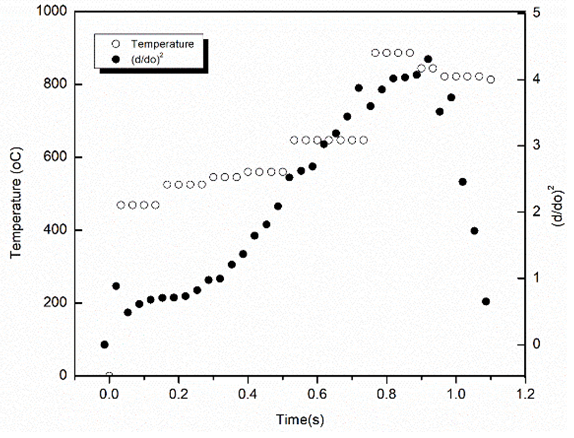Main Article Content
Abstract
One of the strong candidates for biodiesel is Crude Coconut Oil (CCO) but its high viscosity cannot be applied directly without treatment. Therefore, nanocarbon is added to reduce the viscosity of CCO. Nanocarbon is a natural material with semiconductor properties, a good heat conductor, and can attract other molecules. By adding nanocarbon, it is expected to reduce the viscosity of CCO. This study aimed to determine the combustion characteristics of droplets on CCO by adding nanocarbon by 1% and 5%. The method used was a true experiment with droplets, which dripped on the thermocouple with activation energy from the heater. The results showed that CCO burned 0.933s with a droplet diameter of 4.307mm, droplet diameter of 5.472 mm. By adding 5% nanocarbon to CCO, the CCO burned faster, more reactive, and the ignition was shorter than the pure CCO and 1% CCO.
Keywords
Article Details

This work is licensed under a Creative Commons Attribution-NonCommercial 4.0 International License.
References
- J. Blin et al., “Characteristics of vegetable oils for use as fuel in stationary diesel engines—Towards specifications for a standard in West Africa,” Renewable and Sustainable Energy Reviews, vol. 22, pp. 580–597, 2013.
- A. Kolakoti, M. Setiyo, and B. Waluyo, “Biodiesel Production from Waste Cooking Oil: Characterization, Modeling and Optimization,” Mechanical Engineering for Society and Industry, vol. 1, no. 1, pp. 22–30, 2021, doi: 10.31603/mesi.5320.
- Y. Zetra, S. M. W. Sholihah, R. Y. P. Burhan, and R. A. Firmansyah, “Synthesis and Characterization of Diesel Lubricity Enhancer through Transesterification Reaction of Palm Oil with 1, 2-Ethanediol,” Automotive Experiences, vol. 4, no. 2, pp. 104–111, 2021.
- R. A. B. Hariyanto, R. A. Firmansyah, R. Y. P. Burhan, and Y. Zetra, “Synthesis of Bio-additive for Low Sulphur Diesel: Transesterification of Soybean Oil and Ethylene Glycol using K2CO3 Catalyst,” Automotive Experiences, vol. 4, no. 1, pp. 44–50, 2021.
- I. N. G. Wardana, “Combustion characteristics of jatropha oil droplet at various oil temperatures,” Fuel, vol. 89, no. 3, pp. 659–664, 2010.
- P. Hellier, N. Ladommatos, and T. Yusaf, “The influence of straight vegetable oil fatty acid composition on compression ignition combustion and emissions,” Fuel, vol. 143, pp. 131–143, 2015.
- R. D. Misra and M. S. Murthy, “Blending of additives with biodiesels to improve the cold flow properties, combustion and emission performance in a compression ignition engine—A review,” Renewable and sustainable energy reviews, vol. 15, no. 5, pp. 2413–2422, 2011.
- M. Setiyo, D. Yuvenda, and O. D. Samuel, “The Concise Latest Report on the Advantages and Disadvantages of Pure Biodiesel (B100) on Engine Performance: Literature Review and Bibliometric Analysis,” Indonesian Journal of Science and Technology, vol. 6, no. 3, pp. 469–490, 2021, doi: 10.17509/ijost.v6i3.38430.
- R. D. Misra and M. S. Murthy, “Jatropa—the future fuel of India,” Renewable and Sustainable Energy Reviews, vol. 15, no. 2, pp. 1350–1359, 2011.
- H. Y. Nanlohy, H. Riupassa, I. M. Rasta, and M. Yamaguchi, “An Experimental Study on the Ignition Behavior of Blended Fuels Droplets with Crude Coconut Oil and Liquid Metal Catalyst,” Automotive Experiences, vol. 3, no. 2, 2020.
- I. G. K. Puja, I. N. G. Wardana, Y. S. Irawan, and M. A. Choiron, “The role of Carica papaya latex and aluminum oxide on the formation of carbon nanofibre made of coconut shell,” Advances in Natural Sciences: Nanoscience and Nanotechnology, vol. 9, no. 3, p. 35021, 2018.
- E. Marlina, W. Wijayanti, L. Yuliati, and I. N. G. Wardana, “The role of pole and molecular geometry of fatty acids in vegetable oils droplet on ignition and boiling characteristics,” Renewable Energy, vol. 145, pp. 596–603, 2020.
- H. Y. Nanlohy, I. N. G. Wardana, N. Hamidi, L. Yuliati, and T. Ueda, “The effect of Rh3+ catalyst on the combustion characteristics of crude vegetable oil droplets,” Fuel, vol. 220, pp. 220–232, 2018.
- M. Chinnamma et al., “Production of coconut methyl ester (CME) and glycerol from coconut (Cocos nucifera) oil and the functional feasibility of CME as biofuel in diesel engine,” Fuel, vol. 140, pp. 4–9, 2015.
- Y. C. Liu, Y. Xu, C. T. Avedisian, and M. C. Hicks, “The effect of support fibers on micro-convection in droplet combustion experiments,” Proceedings of the Combustion Institute, vol. 35, no. 2, pp. 1709–1716, 2015, doi: https://doi.org/10.1016/j.proci.2014.07.022.
- D. Shringi, H. A. Dwyer, and B. D. Shaw, “Influences of support fibers on vaporizing fuel droplets,” Computers and Fluids, vol. 77, no. Complete, pp. 66–75, 2013, doi: 10.1016/j.compfluid.2013.02.005.
- M. Ghamari and A. Ratner, “Combustion characteristics of diesel and Jet-A droplets blended with polymeric additive,” Fuel, vol. 178, pp. 63–70, 2016.
- M. Ghamari and A. Ratner, “Combustion characteristics of colloidal droplets of jet fuel and carbon based nanoparticles,” Fuel, vol. 188, pp. 182–189, 2017.
- E. Marlina, I. N. G. Wardana, L. Yuliati, and W. Wijayanti, “The effect of fatty acid polarity on the combustion characteristics of vegetable oils droplets,” in IOP Conference Series: Materials Science and Engineering, 2019, vol. 494, no. 1, p. 12036.
- V. Dee and B. D. Shaw, “Combustion of propanol–glycerol mixture droplets in reduced gravity,” International journal of heat and mass transfer, vol. 47, no. 22, pp. 4857–4867, 2004.
- E. Marlina, M. Basjir, M. Ichiyanagi, T. Suzuki, G. J. Gotama, and W. Anggono, “The Role of Eucalyptus Oil in Crude Palm Oil As Biodiesel Fuel,” Automotive Experiences, vol. 3, no. 1, pp. 33–38, 2020.
- I. Jeong, K.-H. Lee, and J. Kim, “Characteristics of auto-ignition and micro-explosion behavior of a single droplet of water-in-fuel,” Journal of Mechanical Science and Technology, vol. 22, no. 1, pp. 148–156, 2008.

